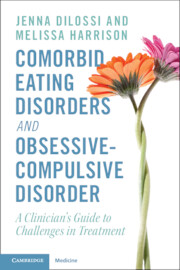 Comorbid Eating Disorders and Obsessive-Compulsive Disorder
Comorbid Eating Disorders and Obsessive-Compulsive Disorder from Part II - Clinical Pitfalls and Treatment Failures
Published online by Cambridge University Press: 14 December 2023
The treatment of underweight and malnourished individuals with eating disorders (EDs) and obsessive-compulsive disorder (OCD) poses unique challenges and considerations. Low weight and malnourishment have implications on symptom presentation, treatment course, and outcomes. Clinicians should consider the impact of malnourishment on organ systems, the importance of medical care in treatment, and dietary considerations for weight restoration. Restrictive eating disorders such as AN and atypical AN can lead to similar psychological effects of malnourishment even if not underweight. Current ED treatment programs consider all patients as having malnutrition effects due to their illness, regardless of BMI. Atypical AN often goes unnoticed, leading to reinforcement of disordered eating behavior. Chronic malnutrition and starvation can affect almost every major organ system and result in permanent damage or death if not addressed. Additionally, underweight or malnourished patients often have a lot of dietary needs and need a lot of calories for restoration, which can be complicated by OCD symptoms such as obsessionality and intolerance of uncertainty.
To save this book to your Kindle, first ensure no-reply@cambridge.org is added to your Approved Personal Document E-mail List under your Personal Document Settings on the Manage Your Content and Devices page of your Amazon account. Then enter the ‘name’ part of your Kindle email address below. Find out more about saving to your Kindle.
Note you can select to save to either the @free.kindle.com or @kindle.com variations. ‘@free.kindle.com’ emails are free but can only be saved to your device when it is connected to wi-fi. ‘@kindle.com’ emails can be delivered even when you are not connected to wi-fi, but note that service fees apply.
Find out more about the Kindle Personal Document Service.
To save content items to your account, please confirm that you agree to abide by our usage policies. If this is the first time you use this feature, you will be asked to authorise Cambridge Core to connect with your account. Find out more about saving content to Dropbox.
To save content items to your account, please confirm that you agree to abide by our usage policies. If this is the first time you use this feature, you will be asked to authorise Cambridge Core to connect with your account. Find out more about saving content to Google Drive.